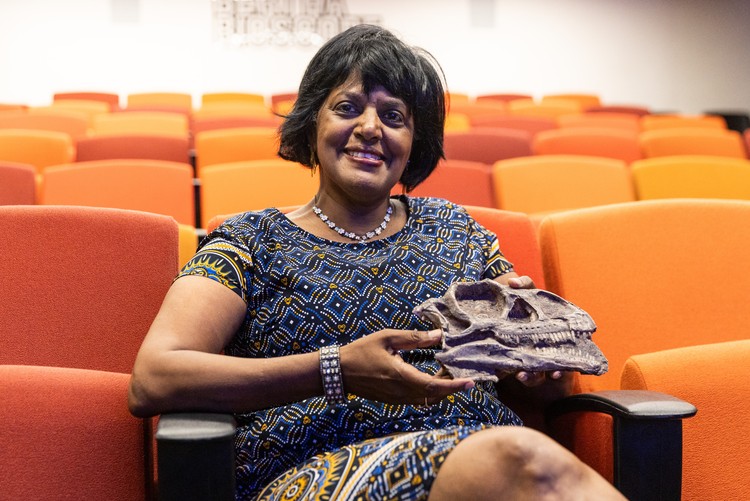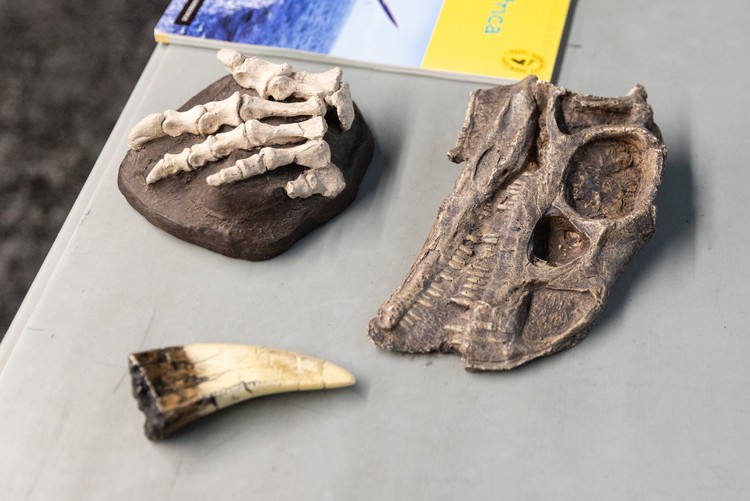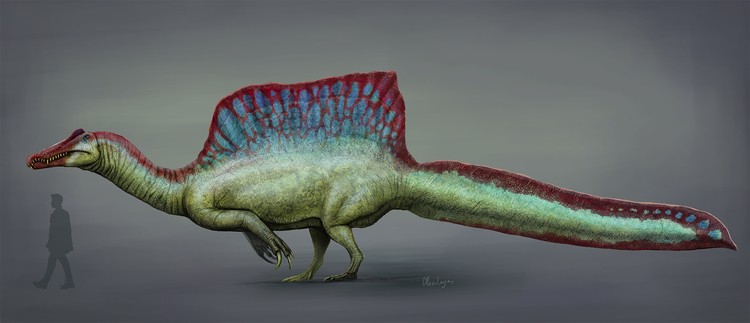African dinosaurs and the sixth mass extinction
Palaeobiologist Anusuya Chinsamy-Turan speaks at GroundUp’s Science for the People seminar
Professor Anusuya Chinsamy-Turan holds the fossilised skull of Massospondylus, an African dinosaur. Photo: Ashraf Hendricks
“It’s really important that we realise we need to take better care of the planet, otherwise we’ll also go the way of the dinosaur,” said Anusuya Chinsamy-Turan, palaeobiologist and professor at the University of Cape Town.
She was speaking at GroundUp’s final Science for the People seminar for the year, hosted at Bertha House in Cape Town on Friday 1 December.
Chinsamy-Turan has a species of Sabre-toothed cat named after her.
The topic of the discussion was African dinosaurs. Chinsamy-Turan described several dinosaur species whose fossils have been found across the continent.
Over 40 people attended, including a group of high-school students. The crowd was in awe of the fossils and casts of dinosaur parts that she passed around for people to touch and feel. A particular crowd-pleaser was the tooth of a T-Rex.
Chinsamy-Turan started off by asking the audience if they could name an African dinosaur. Someone shouted T-Rex, made famous by the Jurassic Park movies. But, Chinsamy-Turan explained, the Tyrannosaurus rex was not an African dinosaur. In fact, no one in the audience could name an African dinosaur.
Chinsamy-Turan then treated the audience to descriptions and artist impressions of a fascinating variety of African dinosaurs, such as the Carcharodontosaurus, Africa’s “top predator”, a match in size for the T-Rex, and the Spinosaurus, a fish-eating dinosaur that had adaptations for swimming, and made an appearance in one of the later Jurassic Park films.
Chinsamy-Turan described the discovery of a new dinosaur species in Kirkwood, Eastern Cape in 2022. The creature has been given an isiXhosa name, Iyuku raathi. She also pointed out that in the early 1900s dinosaur fossils were discovered in Tanzania, but “none of these are on display” there. Instead they are in a museum in Germany.
These specimens entertained the audience. At the bottom of the photo is a T-Rex tooth. Photo: Ashraf Hendricks
While dinosaurs may superficially seem to be a topic of little relevance to contemporary problems, Chinsamy-Turan explained an important lesson to be learnt from their extinction. About 65-million years ago most species were wiped out including the dinosaurs. Changes to the environment made the planet uninhabitable for dinosaurs. “There is a lot of evidence to suggest it might have been caused by an asteroid impacting earth,” Chinsamy-Turan said.
But strictly speaking not all dinosaurs went extinct, the professor explained. Dinosaurs are the ancestors of birds. (Birds evolved from a group of meat-eating dinosaurs called theropods, explains the Natural History Museum in the UK.)
Chinsamy-Turan then turned her attention to the sixth mass extinction currently underway, which is being driven by humans. The drivers of the extinction are climate change, urbanisation, pollution, and habitat loss. “All of this is driven by what humans are doing to the planet,” she said.
She also described how many bird species, whose ancestors survived the last great extinction, have gone extinct because of humans, such as the Dodo and the Elephant Bird. “It’s a sad thing to note if you look at where this lineage comes from,” she said.
Citing BirdLife International data, Chinsamy-Turan noted that nearly half of the world’s bird species are in decline. She emphasised that it’s not just birds, but all of our biodiversity that is under threat. And the “biggest culprits” are human beings.
“We know that humans on the planet have a very small history. At the very most we can say humans have been on the planet for four million years. But we know that the history on the planet, with life on earth, goes back 3.7-billion years,” she said.
“We are leading to the extinction of so many different species … We certainly need to realise that the future of our planet lies in our own hands. We need to take charge of how we treat our planet.”
Reconstruction of a Spinosaurus, an African dinosaur. Image: Mario Lanzas via Wikimedia (CC BY-SA 4.0)
Support independent journalism
Donate using Payfast

Don't miss out on the latest news
We respect your privacy, and promise we won't spam you.
Next: Third qualified audit in a row for National Lotteries Commission
Previous: More than 100 homes destroyed in Philippi weekend blaze
© 2023 GroundUp. This article is licensed under a Creative Commons Attribution-NoDerivatives 4.0 International License.
You may republish this article, so long as you credit the authors and GroundUp, and do not change the text. Please include a link back to the original article.
We put an invisible pixel in the article so that we can count traffic to republishers. All analytics tools are solely on our servers. We do not give our logs to any third party. Logs are deleted after two weeks. We do not use any IP address identifying information except to count regional traffic. We are solely interested in counting hits, not tracking users. If you republish, please do not delete the invisible pixel.



